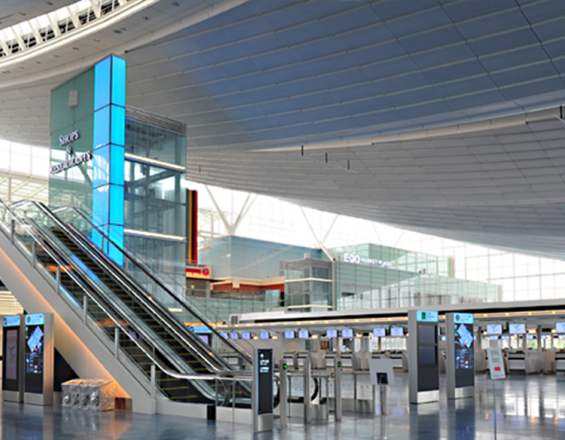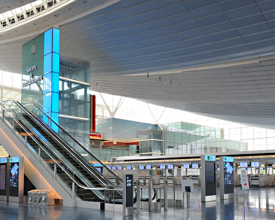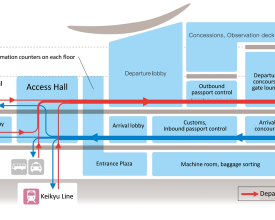
Making Airport More Accessible for All through Public-private Collaboration

Haneda International Airport Terminal (Tokyo International Airport) was built in 2010, when the fourth runway was extensively developed. Thanks to the high market potential, a private financial initiative scheme was applied to build and operate the international terminal. Under this scheme, thirteen private companies jointly funded Tokyo International Airport Terminal Corporation (TIAT), a special purpose company. It increased physical accessibility in and around the new airport terminal, which improved social inclusiveness of the elderly, disabled, and other people with mobility limitation. Also, TIAT, the national and local governments, airline companies, and public transportation companies closely collaborated to materialize seamless air travel access.
Context
Challenges addressed
As Japan has been facing rapid globalization and drastic changes in its demography, such as the continuously declining birthrate and increasing life expectancy, “Universal Design” concept has been widely applied to support economic and social activities, particularly through the application to public transport design. To produce safe and livable environments and enable all people to reach basic urban services in an aging society, there is an urgent need to upgrade transportation facilities to be equitably accessible, understandable and usable to people of all ages and abilities.
Location
Process
Summary of the process
In the context of globalization and aging society, airport terminals are increasingly used by a variety of international and domestic travellers. However, around the world, there are many physical barriers that hamper people with disabilities from having a comfortable travel experience in and around terminals. In the case of Tokyo, multiple private companies took up the challenge to apply the Universal Design concept and cutting-edge technologies to produce a world-class international airport terminal from the planning/design stage. Therefore, the building blocks present the thoughtful and interactive design process, endeavors of airport and railway companies for integrated access to and from urban centers, and a framework of public sector guidance and private sector initiatives for the capital improvements.
Building Blocks
Thoughtful and Interactive Design Process
The universal design committee organized approximately forty universal design workshops and reflected the opinions collected from a wide range of users to the detailed drawing of the terminal. The members also visited existing airport facilities and used mock-ups to assess the effect of the design plan. As a result of these joint design efforts, the terminal successfully provides seamless access to public transportation, especially railways. It also progressively introduced world-class terminal facilities with the Universal Design concept; Multipurpose toilets, boarding bridges, and versatile concierge service and communication devices exemplify its novelty.
Enabling factors
- Establishing a universal design committee as a coordinating board
- Organizing universal design workshops that allow governments and private companies to gather more input from airport users into design of facilities.
- Strong private players (NGOs, community development conference, etc.) active in promoting universal design
Lesson learned
Airport terminals require several special facilities related to a series of air travel procedures, such as security checks, embarking and disembarking, immigration, and lengthy waiting times. To increase access to the terminal for everyone, the usability of all facilities needs to be scrutinized and should reflect the voices from a range of actual users.
Integrated Access to and from Urban Centers
The design of the airport itself is half of the success equation - how to ensure seamless door-to-door travel experience for various people including the elderly and disabled is a key. Haneda International Airport Terminal is directly connected to the city’s major urban centers by two railway companies. When the new terminal and stations were built, TIAT and these two railway companies collaborated to get rid of physical barriers across facilities for people with mobility disadvantages. For example, a hall in the terminal allows passengers to directly access to departure/arrival lobbies, public transportation services (e.g., Monorail, railway, buses, and taxies) and a car parking area via flat and straight paths. Several large-size elevators set in the station can also carry a large volume of passengers between the platforms and the arrival/departure floors. A railway line redirected the guideway from the existing platform at the domestic terminal to the second floor of the international terminal to produce flat passenger access from the station to the departure lobby. In addition, the both railway lines introduced movable step boards that bridge train vehicles and platforms for wheelchair users, and platform screen doors for passengers’ safety.
Enabling factors
-
Coordination of facility design with railway companies providing access to the airport
Lesson learned
Integrated access design between an airport terminal, ground transportation systems, and urban centers is critical for travelers with disabilities. In particular, it is essential to eliminate all types of level differences and floor gaps that can cause stress and hamper passengers from having seamless door-to-door travel experiences. Incorporating a centralized hall into the terminal benefits all users, as it enables smooth transfers among different transportation modes with barrier-free paths and, in turn, mitigates pedestrian congestion at airports.
Public Sector Guidance Coupled with Private Sector Initiatives
To address a social need for transportation facilities equitably accessible, understandable and usable to people of all ages and abilities, the national government enacted a law to promote smooth transportation to the elderly, disabled and others in 2006. It set a target to adopt the concept of Universal Design by 2020 for all public transportation facilities, including airports that serve more than 3,000 daily passengers. Under this law, the government developed “Universal Design Guideline”, which is also applicable to improvement of Haneda International Airport. Not only did TIAT follow this guideline, it as a private company made extensive efforts to offer a comfortable space and enhanced accessibility to all types of airport visitors.
Enabling factors
-
Strong drive from the national government to consider universal accessibility in infrastructure design
-
Detailed guidelines to develop universally accessible infrastructure
Lesson learned
A key tenet of the philosophy of Universal Design is that the facility improvements needed to support people with disabilities can benefit everyone. Increased physical accessibility and hospitality satisfy customers with the high-quality of services and contribute to increasing the number of airport users to some extent. While the national government plays a pivotal role in adopting the Universal Design concept in public transportation facilities, private terminal operators should be motivated to proactively install innovative technologies and unconventional services for long-term cost saving and customer (passenger) satisfaction.
Impacts
Economic Impact: Introducing the Universal Design concept to the entire terminal building can save the total cost of design and construction, as it does not require different design adaptations or specialized design for certain people. The terminal supported by progressive services and technologies are also likely to offer better travel experiences, attract more international passengers, and, in turn, increase airport operation revenues.
Social Impact: The increased physical accessibility in and around the airport terminal significantly improved the social inclusiveness of the elderly, disabled, and other people with mobility limitations. In addition, the progressive services and devices, such as pictogram signage, multilingual guides, and concierge’s assistance, help to provide hospitality to international visitors through the gateway.
Environmental Impact: The proportion of public transportation (railway and bus services) in the airport access/egress market has gradually been increasing since the international terminal was opened. It is likely that better intermodal services with seamless access could shift air passengers from personal vehicles to public transportation systems, which contribute to reducing road traffic congestion and CO2 emissions.
Beneficiaries
- All users of Haneda International Airport Terminal
- Airport operators, airport retail tenants, and airline companies


